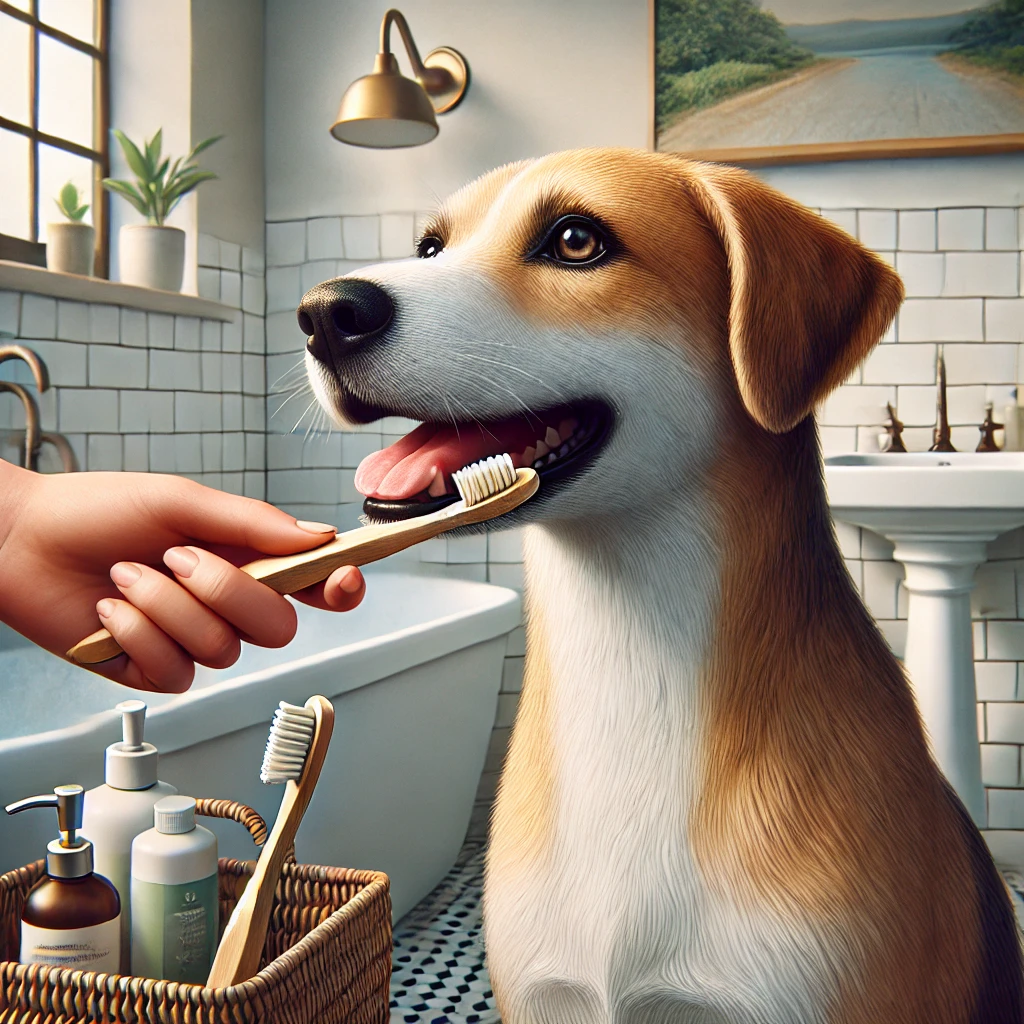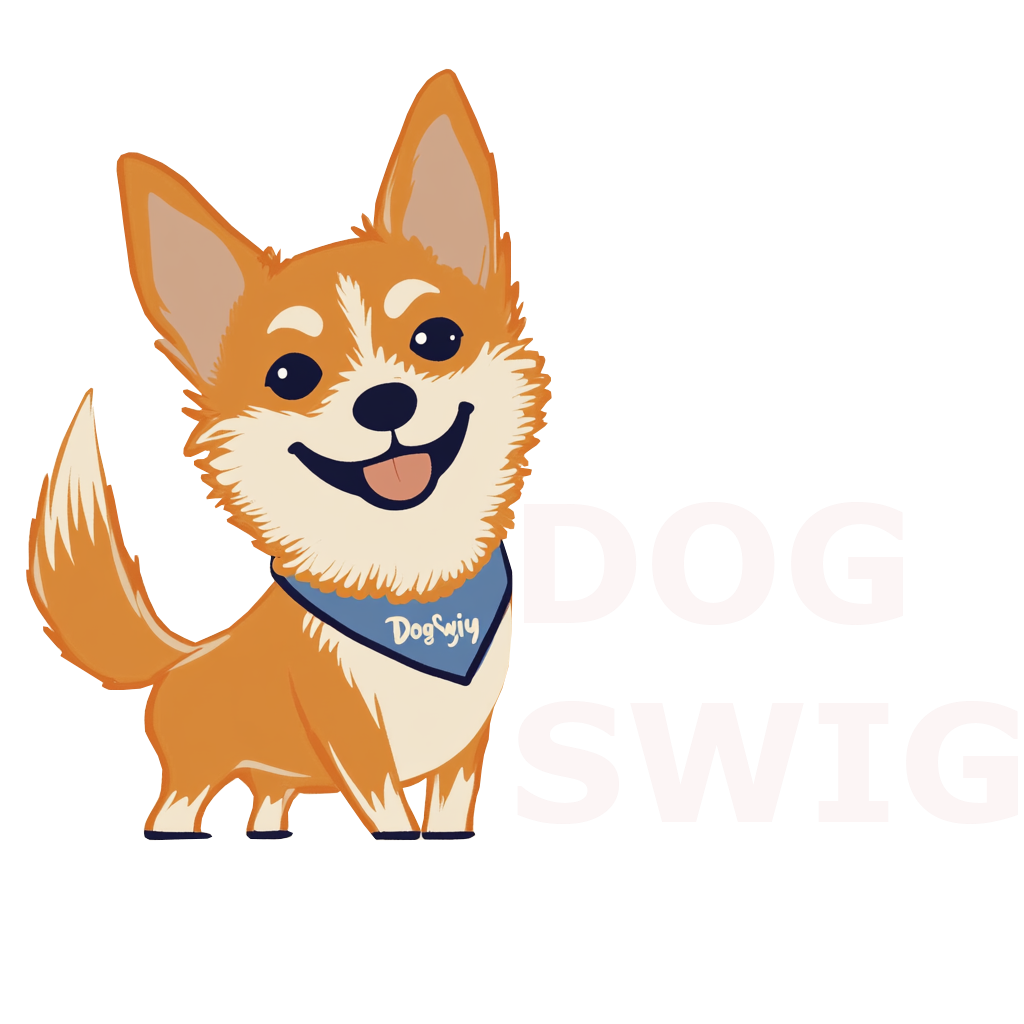Keep Your Dog’s Smile Healthy: Essential Tips for Tooth and Mouth Hygiene – Everything Dog Series.

As pet owners, we care about our dogs’ health from head to tail. But one area that often goes unnoticed is oral hygiene. Good dental care is essential for keeping your dog’s teeth and gums healthy, preventing bad breath, and reducing the risk of serious health issues.
Why Dental Hygiene is Essential for Dogs
Did you know that dogs are prone to the same dental issues as humans? Plaque, tartar buildup, and gum disease can cause discomfort, lead to tooth loss, and even contribute to heart, liver, and kidney problems. Regular dental care can help prevent these issues, ensuring your dog stays happy and healthy.
1. Brush Their Teeth Regularly
Just like us, dogs benefit from regular brushing. Using a dog-specific toothbrush and toothpaste is essential. At Dog Swig, we offer eco-friendly bamboo toothbrushes that are gentle on gums and designed to effectively clean away plaque. Start slow, and make brushing a positive experience for your dog.
2. Offer Dental Chews and Toys
Dental chews and toys can help remove food particles and plaque from your dog’s teeth as they chew. Look for natural, eco-friendly options that support oral health without synthetic additives. Browse our collection of safe, sustainable dental toys for a happy, healthy mouth.
3. Use Water Additives for Extra Freshness
Some dogs resist brushing, which is where water additives can be a helpful alternative. These products, when added to your dog’s water bowl, work to fight bacteria and reduce plaque. Choose products free from artificial flavors and chemicals to keep your dog’s water safe.
4. Regular Dental Check-Ups with Your Vet
Your veterinarian is a crucial ally in maintaining your dog’s dental health. During annual exams, your vet will check for signs of dental disease and may recommend a professional cleaning. If your dog has any unusual symptoms, like difficulty chewing, drooling, or pawing at their mouth, be sure to schedule a visit. (Pet Dental Care)
5. Incorporate Healthy Treats
Treats can also play a role in maintaining oral hygiene. Look for crunchy, low-sugar treats that naturally scrape away plaque as your dog chews. At Dog Swig, we prioritize eco-conscious, healthy treat options that support your dog’s overall well-being. Check out our sustainable treat options to keep your pup’s teeth in top shape. (Treats For Dogs – Study)
Final Thoughts: Start a Routine Early
The sooner you start a dental care routine with your dog, the better! Dogs that are accustomed to tooth brushing, dental chews, and regular vet check-ups have healthier mouths and fresher breath as they age.
Investing in your dog’s dental health doesn’t just mean a healthier mouth; it’s an investment in their overall quality of life. Check out Dog Swig’s eco-friendly pet products to find everything you need for your dog’s dental hygiene routine, from toothbrushes to all-natural chews. A clean mouth is just a step away!
Everything Dog Series.
Why You Should Switch to Dog-Specific Soap for Your Furry Friend
As pet owners, we all want the best for our dogs, and that includes their grooming routine. While human soaps and shampoos might seem like an easy option, they’re not ideal for your dog’s sensitive skin. That’s where specially formulated dog soap comes in—it’s designed to keep your pup clean, healthy, and happy.
What Makes Dog Soap Different?
Dog soap is crafted with your pet’s unique needs in mind. Unlike human products, which can strip away natural oils and irritate your dog’s skin, dog soap is pH-balanced and gentle. Many dog soaps include natural ingredients like oatmeal, aloe vera, or coconut oil, which soothe the skin and promote a healthy coat.
For eco-conscious pet owners, there are even biodegradable and sustainable options available, ensuring that your grooming routine is kind to the planet.
Benefits of Using Dog Soap
- Gentle on Skin: Dog soap is specifically designed for a dog’s skin, reducing the risk of dryness, flakiness, and irritation.
- Natural Ingredients: Many options are made with hypoallergenic, natural ingredients that are safe for sensitive pups.
- Effective Cleaning: Removes dirt, odors, and bacteria without over-drying or leaving harsh residues.
- Targeted Formulas: Choose from soaps designed to address specific issues like fleas, itching, or dry skin.
How to Choose the Right Dog Soap
When selecting dog soap, look for products with natural, non-toxic ingredients. Avoid harsh chemicals, artificial fragrances, and parabens. If your dog has sensitive skin or allergies, opt for unscented or hypoallergenic options. For a refreshing, all-natural solution, check out Dog Swig’s eco-friendly dog soap options.
Tips for Bathing Your Dog
- Brush First: Remove loose fur and tangles before bath time.
- Use Lukewarm Water: Ensure the water is comfortable to prevent stress.
- Lather Gently: Work the soap into a rich lather, avoiding the eyes and ears.
- Rinse Thoroughly: Make sure no residue is left behind.
- Dry Properly: Use a towel or let your dog air dry in a warm space.
Final Thoughts
Dog soap is an essential part of keeping your pet clean and healthy. By using a soap specifically designed for dogs, you’re not only improving their coat and skin but also ensuring a safer, more comfortable grooming experience. Ready to upgrade your pup’s bath time? Explore our range of dog grooming essentials to find the perfect soap for your furry friend.

How to Know if Your Dog Is Happy: Signs of a Content Pup
Understanding your dog’s happiness is essential for their well-being. Dogs communicate their emotions through body language and behavior. Recognizing these signs can help ensure your furry friend is content and healthy.
1. Relaxed Body Language
A happy dog exhibits a loose, wiggly body posture. Their muscles are relaxed, and movements are fluid. A tense or stiff body may indicate discomfort or stress. PetMD
2. Tail Wagging
While tail wagging is commonly associated with happiness, it’s important to consider the tail’s position and movement. A gentle, loose wag with the tail in a neutral position often signifies contentment. However, a high, stiff wag can indicate alertness or agitation. Reader’s Digest
3. Playfulness
Engaging in play is a clear sign of a happy dog. Behaviors like the “play bow,” where the dog lowers their front legs and keeps their rear up, invite interaction and indicate joy. Rover
4. Healthy Appetite
A dog that eagerly eats and shows interest in treats is generally in good spirits. Conversely, a sudden loss of appetite may signal health issues or emotional distress. iHeartDogs
5. Affectionate Behavior
Seeking physical contact, such as leaning against you or cuddling, demonstrates trust and happiness. Happy dogs often desire closeness with their owners. iHeartDogs
6. Regular Sleep Patterns
Content dogs have consistent sleep routines and wake up refreshed. Changes in sleep patterns can indicate stress or health concerns.
7. Soft Facial Expressions
A relaxed face with soft eyes and a slightly open mouth resembles a smile and indicates a happy dog. Tension around the eyes or mouth can be a sign of discomfort. Reader’s Digest
8. Social Behavior
Happy dogs are often sociable, enjoying interactions with humans and other animals. They may greet you enthusiastically and show curiosity about their surroundings.
9. Balanced Energy Levels
A happy dog displays a healthy balance of energy, being playful yet able to relax. Excessive hyperactivity or lethargy can be signs of underlying issues.
10. Good Health
Overall health is a strong indicator of happiness. Regular vet check-ups, a balanced diet, and proper grooming contribute to your dog’s well-being.
By observing these signs, you can better understand your dog’s emotional state and take steps to maintain their happiness. Providing a loving environment, regular exercise, mental stimulation, and social interaction are key to a joyful and healthy dog.
For more insights on canine behavior and well-being, consider exploring resources from reputable organizations like the American Kennel Club and PetMD.
Everything Dog Series.
